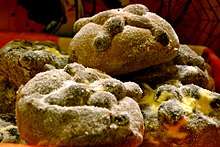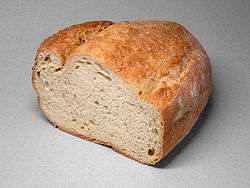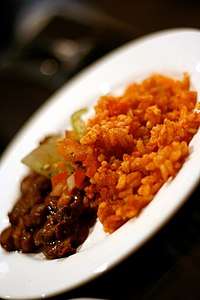Pan de muerto
Pan de muerto (Spanish for '"bread of the dead"'), also called pan de los muertos in Mexico, is a type of pan dulce traditionally baked in Mexico during the weeks leading up to the Día de Muertos, which is celebrated from October 31st to November 2nd.[1]
 | |
| Alternative names | Bread of the dead |
|---|---|
| Type | Sweet bread |
| Place of origin | Mexico |
Description
It is a sweetened soft bread shaped like a bun, often decorated with bone-shaped phalange pieces. Pan de muerto is eaten on Día de Muertos, at the gravesite or alternatively, at a tribute called an ofrenda. In some regions, it is eaten for months before the official celebration of Dia de Muertos. In Oaxaca, pan de muerto is the same bread that is usually baked, with the addition of decorations. As part of the celebration, loved ones eat pan de muerto as well as the relative's favorite foods. The bones represent the deceased one (difuntos or difuntas) and there is normally a baked tear drop on the bread to represent goddess Chīmalmā's tears for the living. The bones are represented in a circle to portray the circle of life. The bread is topped with sugar. This bread can be found in Mexican grocery stores in the U.S.
The classic recipe for pan de muerto is a simple sweet bread recipe, often with the addition of anise seeds, and other times flavored with orange flower water or orange zest. Other variations are made depending on the region or the baker. The one baking the bread will usually wear decorated wristbands, a tradition which was originally practiced to protect from burns on the stove or oven.
Bread of the dead usually has skulls or crossbones engraved on it. It is believed the spirits do not eat, but absorb its essence, along with water at their ofrenda, after their long journey back to Earth.
Regional variations
In San Andrés Mixquic, despeinadas (literally, unkempt ones) are made with sprinkles and sesame seeds.[2]
Muertes (deaths), made in the State of Mexico, are made with a mix of sweet and plain dough with a small amount of cinnamon. Other types in the region include gorditas de maíz, aparejos de huevo (egg sinkers, apparently after fishing weights) and huesos (bones).[2]
In Michoacán, breads include pan de ofrenda (offering bread), the shiny pan de hule, (rubber bread) and corn-based corundas, made with tomato sauce and chile de árbol.[2]
References
- Castella, Krystina (October 2010). "Pan de Muerto Recipe". Epicurious. Retrieved 7 July 2015.
- "Pan de muerto: una sabrosa tradición" [Pan de muerto: a tasty tradition]. Vivir Mexico (in Spanish). October 26, 2011.
External links




.jpg)
